Everyone takes pleasure in having beautiful flowers in their gardens and houses. Orchids especially stand out among other flowers because of their varied, elaborate petal designs and vivid color schemes. And their fragrance is simply too enticing to resist! In this article, let’s take a closer look at thrips on orchids.
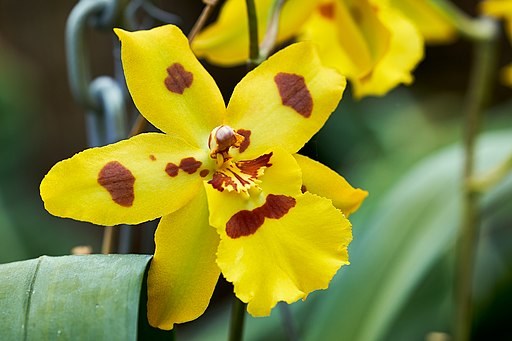
Thrips are common plant pests that feed on the buds and new development of various orchids.
Growing orchids can be a joyful experience if the plants stay healthy and lush. Regrettably, this is not always the case. Your laborious efforts to cultivate beautiful flowers can be for naught if they fall victim to a pest infestation. With their sweetly scented blossoms and brightly coloured foliage, orchids are a magnet for certain kinds of pests.
One such insect pests are the thrips, which feed especially on orchids. So, if you have orchids in your garden, you must know what causes thrips and how you can get rid of them.
Insecticides such as malathion, insecticidal soap, and acephate (Orthene) are all suggested for thrips control and are also described as safe for orchids. Biological control using a predatory mite is another option if your growing area is enclosed and is not a part of your living environment, such as in a greenhouse.
With that said, there are many more organic, natural, and safe ways to control thrips in an orchid garden. Continue reading to learn more!
How To Identify Thrips?
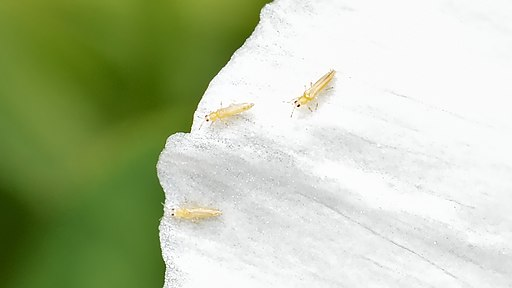
A simple approach to look for thrips is to bang a branch or leaf against a piece of white paper.
Thrips are members of the order Thysanoptera, which is more commonly referred to as thunder flies. They are approximately one millimeter in length and as thin as a needle. Even though they have wings, thrips are not considered very good fliers.
Thrips are often a dark brown tint, yet their color can range from black to a whitish yellow depending on the species and developmental stage.
With the naked eye, they may easily be mistaken for dust particles. Typically, thrips will conceal themselves within the petals of the orchid or beneath the foliage.
If you see the damage but not the actual bug, it undoubtedly thrips! However, if you want to be sure, take a paper towel and place it under an orchid to check for thrips. Afterward, gently shake the bloom or wipe it clean from underneath the orchid leaf.
If there are thrips on your orchids, you will notice tiny, dark brown thrips crawling on the paper towel. Finding thrips is easier because they travel in groups; if you find one on a plant, there are probably ten to twenty others on the same plant.
Related: What are the Best Practices to Get Rid of Thrips on Houseplants?
How Do Thrips Reproduce?
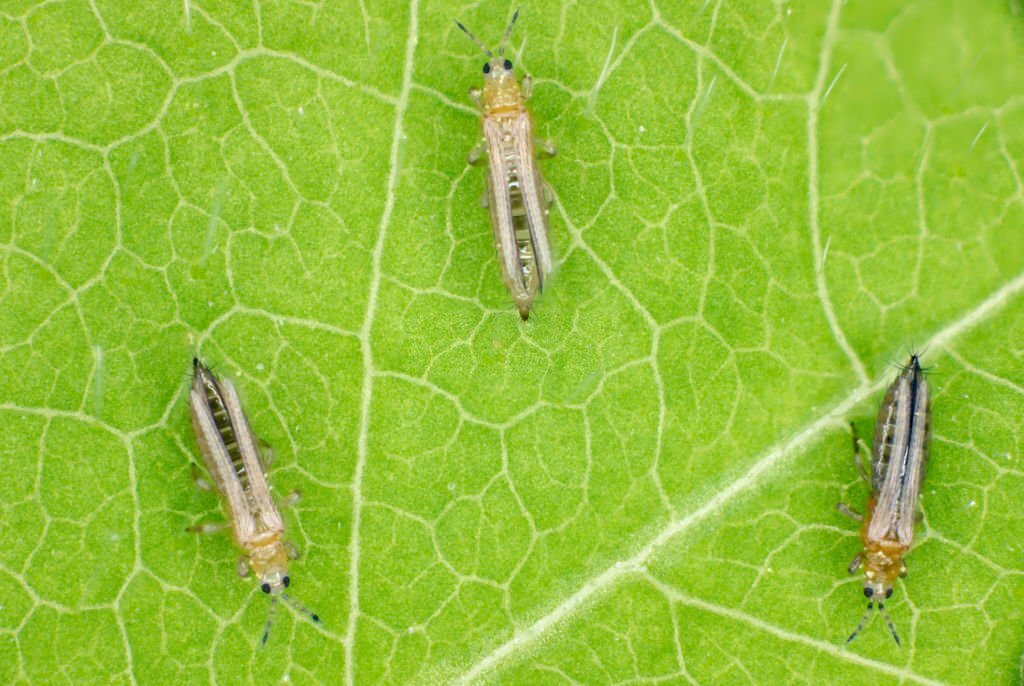
Thrips are just one of the many types of insects that prey on orchids. Their life cycle is relatively short, and they are capable of experiencing rapid population growth in as little as one month. The warmer the climate, the more favorable it is for their development.
It only takes around three to four days for a thrip to mature from an egg into an adult in a warm and humid environment. During the winter, it can take thrips anywhere from one to three weeks to mature from the stage of an egg to that of an adult.
The female thrip will deposit anything from 30 to 50 eggs at once. She conceals the eggs that she lays under the leaves or stems of the orchid plant so that the eggs are not exposed to the sun. The creation of a callus around the egg provides an additional layer of defense against the harmful effects of pesticides.
When the eggs hatch, the nymphs, which are yellowish-white, begin feeding on the orchid. After a short period of time spent dormant on the earth, these nymphs eventually mature into fully-formed adults equipped with wings.
Thrips Damage To The Orchids
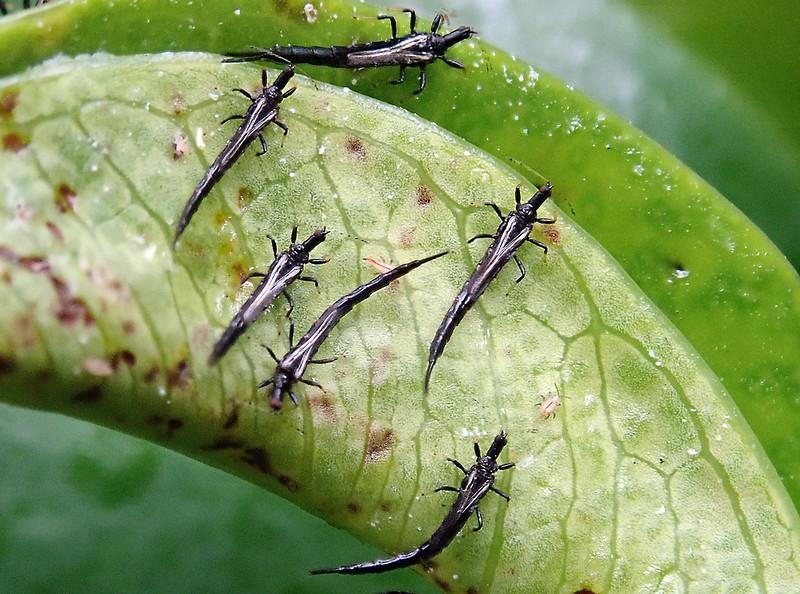
In most cases, the only damage that thrips cause to orchid plants is caused by their feeding.
Thrips cause a significant amount of damage to buds and blooms. They extract the fluids from the plants’ flowers, stems, and leaves by making small holes in the plant tissue. As a direct consequence of this, the foliage turns brown, and the blooms that have been injured develop silver spots or streaks. In addition, the leaves wilt and fall off early, which stunts the plant’s growth, and, in extreme cases, thrips can even kill the orchids.
Not only can thrips cause damage to plant tissue, but they are also responsible for the transmission of over 20 kinds of viruses, most notably the tospoviruses. These viruses cause necrotic rings on the orchid’s leaves, blooms, and stems and are among the most destructive of all plant viruses. In the event that the orchids are infected with these viruses at a young age, it is quite unlikely that they will survive.
Therefore, the best course of action is to take precautions to avoid getting infested by thrips rather than trying to eradicate a thrip infestation on orchids later.
Related: What do Nineteen Must-Have Meaningful Colored Orchids Mean in your Life
How To Prevent Thrips On Orchids?
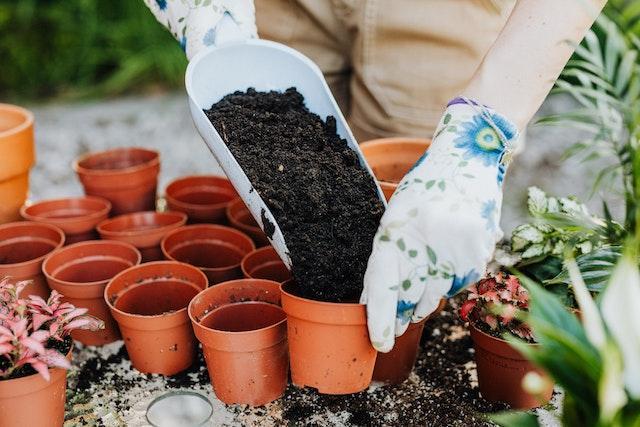
Replacing the potting soil of newly purchased plants with new soil is a simple method of preventing thrips from infesting your orchids.
You must have heard that care is better than cure. That is why preventing thrips invasion on your orchids is far preferable to control them later. There are a few straightforward measures that you can take to prevent thrips from infesting your orchids. In this section, we are going to discuss these preventative measures in depth.
Check New Plants For Thrips
If you’re going to the nursery to pick up some new plants, in this case, orchids, don’t forget to bring along a magnifying lens and some paper towels. Even in daylight, thrips can be hard to see. So, examine the orchids thoroughly, paying close attention to the blossoms beneath the leaves. Hold the white paper towel beneath the bloom and gently shake it; if there is a thrip infestation, you will observe thrips on the white paper towel.
Even if you don’t see any thrips on the orchids when you get them home, it’s best to keep them in a separate room for a week or two. That’s because the plant could have eggs in its soil or under its leaves that might hatch and produce thrips in your garden. And isolating orchids can give you time to take action against pests and safeguard your other plants.
Change The Potting Soil
Even if you check the orchids for bugs when you buy them and believe they are bug-free, as we just mentioned, there may be eggs hidden in the soil that may hatch in the near future. Therefore, the best thing to do would be to repot the orchids and give them new soil to grow in. Indoor potting mix is an excellent product for orchids.
The potting mix goes through a meticulous pest-killing process before being vacuum-sealed and securely packaged to prevent air leakage. When repotting orchids, you should always use extreme caution and be sure to treat the roots of the plant with care.
The process of repotting can be hazardous if done carelessly, as it can cause the roots of the orchid plants to become damaged, even killing the plant.
Maintain Humidity & Moisture
If you want to avoid getting thrips on your orchids, you need to ensure they have the right amount of moisture around them and in the soil, they are growing. If orchids are not consistently watered, they will become susceptible to attack by thrips.
So, maintain a consistent watering schedule for your orchids, and make sure the top layer of soil is never allowed to go completely dry. A humidifier can also be used to improve the humidity levels surrounding the orchids.
Orchids grown outdoors are less likely to be infested by thrips when there is consistent rainfall, as in the rainy season. At the same time, orchids are more vulnerable to thrips infestations when there is little to no moisture, for instance, inside the home.
Use Of Screens
During the warmer months, people often leave their windows open to let the fresh air through. This allows the bugs to infiltrate your home easily and infest your orchids. Thrips can be prevented from entering your home using a mesh with narrower holes.
Screens with holes smaller than 1/16 inch are optimal for most applications.
So, ensure that all of the windows in the house are screened so that you won’t have to worry about pests. And, if you have your orchids planted on your lawn, you can protect them with netting to keep thrips and other insects and animals from attacking them.
Related: How Stunning Dyeing Orchids Blue is Possible with Hassle Free Fun Ways
Controlling Thrips On Your Orchids
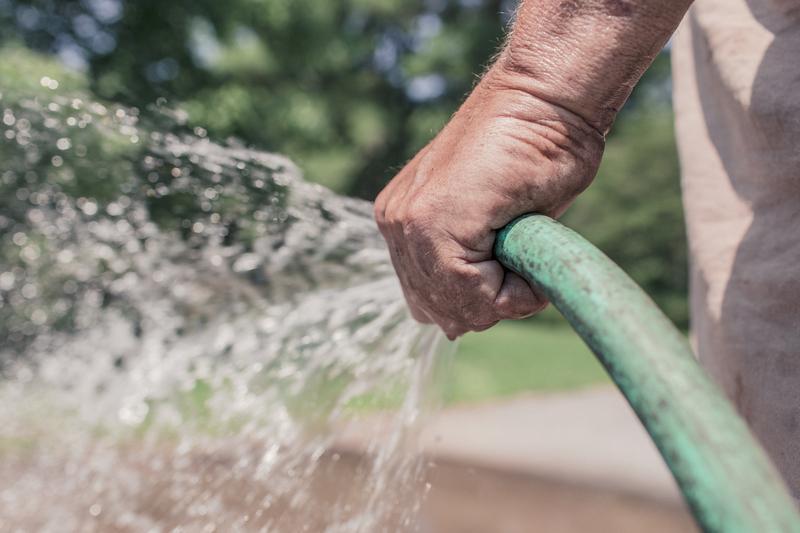
Thrips can be dislodged from orchids with a gentle spray of water from a garden hose.
Do not be concerned if you were unable to prevent thrips from infesting your orchid plants for any reason; they can still be controlled. If you need help getting rid of thrips, here is a list of some practical, tested, and proven options.
Knock Thrips Off Orchids With A Water Hose
This strategy will only be successful if the infestation is still in its early stages and there are not a significant number of thrips present on the orchids. Spray the orchids with water and concentrate your efforts on the areas under the leaves and petals, which are known to be thrips’ hiding spots.
Be careful that the water pressure is not too high; otherwise, the strong water stream may cause the delicate flowers and foliage to disintegrate and fall off. Try to do this first thing in the morning so that the surplus water can evaporate before it becomes dark.
Sticky Traps For Thrips
Sticky traps are most effective against bugs that can fly or jump. Sticky traps can be hung near blooms or leaves of your plant to catch thrips, which are unable to escape from the traps once they become stuck.
On the sticky traps, the thrips appear as specks or tiny dark dots of varying sizes. Keep rotating the sticky traps so new thrips can get stuck on the fresh sticky surfaces.
Although sticky traps are best used for spotting thrips rather than suppressing them, they are still somewhat effective in reducing their numbers on orchids.
Insecticidal Soap
Thrips can also be eradicated using insecticidal soap, which destroys the thrips’ exoskeletons and ruptures their cell membranes. Ready-to-use insecticidal spray bottles are easily accessible online and in gardening stores.
You should spray the insecticidal soap on the orchids in the morning, aiming it at the sections of the plant where thrips are most likely to be found, such as underneath the leaves or the flower buds, for example.
Do not water the orchids after you have sprayed them. This will cause the insecticidal soap to be washed away and lessen its effectiveness against thrips.
Natural Predators
This solution may or may not be appropriate for you, depending on where you keep your orchids. If your orchids are kept outside, you can release predatory mites to assist naturally in reducing the number of thrips.
These mites feed on thrips and then their eggs on the host plant. You cannot, however, apply insecticides at the same time if you choose to employ this form of thrips control because the insecticides will eliminate the spider mites as well.
To begin, we suggest using live predatory mites and the live mites by Nature’s Good Guys.
Neem Oil
Neem seeds contain many natural pesticides, with azadirachtin having the most potent insecticidal properties. Neem oil kills thrips by obstructing the pores on their bodies that they need for respiration. Moreover, it inhibits thrips’ metabolism and ultimately kills them by interfering with their digestive enzymes.
Neem oil needs an emulsifying agent like soap or dish detergent to mix with water. Add a gallon of warm water and one to two tablespoons of dish soap to your sprayer.
Spray this solution on your plants, paying particular attention to the blooms and the underside of the leaves because these are the places where thrips like to hide. Spray the orchids once a week until the thrips have gone away.
Det Rid Of Thrips On Orchids Using Insecticides
You should only use chemical and synthetic insecticides as a last option. They are harmful to the environment as well as beneficial insects that might be present in your garden.
Also, the use of pesticides is incompatible with the use of predatory mites for control because the insecticides are toxic to both the mites and the thrips. When using the product, always follow the label’s instructions and dilute it if necessary.
Spray the orchid thoroughly with the solution, and continue doing so once every five days until you can no longer find any thrips on the plant.
To eliminate thrips, you can apply insecticidal soap, malathion, or acephate (Orthene), all of which are labeled as non-toxic to orchids.
Conclusion
Orchids are susceptible to damage by thrips, and it can be challenging to get rid of them once the infestation has spread. The good news is that it need not be overwhelmingly difficult. Identifying the problem is the first step toward isolating it and fixing it.
One or more of the strategies I described can be used to deal with a thrips infestation, depending on its severity. Next, after the thrips infestation has been eliminated, you must take precautions to ensure that the problem doesn’t recur.
Wishing you the best of luck as you tend to your orchids. I sincerely hope the information provided here helps you eliminate any thrips damaging your plants.
Frequently Asked Questions
What Does Thrip Damage Look Like On Orchids?
Thrips are frequently seen hiding in orchid flowers or on the undersides of orchid leaves. Thrips feed on the undersides of leaves, especially on thin-leaved orchids. Leaf damage manifests as chlorotic patches, withering, and eventually dropping. Blooms may become prematurely brown, and their petals may become speckled, striped, silvery, or discolored.
Do Thrips Eat Orchids?
Thrips are tiny sucking insects that feed on the most delicate parts of your orchids, such as new leaves, flower buds, flowers, root tips, and so on. Thrips feed in swarms and are incredibly active. When startled, they take to the air by flying or leaping. Damage from thrips results in deformation, early drying, and shedding of buds, flowers, and foliage.
How Do You Treat Thrips On Orchids?
Thrips are one of the most challenging orchid pests to handle. You won’t notice them until they’ve done a lot of damage to the plants. Insecticides such as insecticidal soap, malathion, and acephate (Orthene) are safe to use on orchids and can control thrips.
Can You Use Neem Oil On Orchids?
Neem oil is a natural pesticide and pest deterrent. It is safe to use on orchids and other plants. It is also an excellent option for indoor plants because it is non-toxic to people, pets, and good insects. It can be applied as a foliar spray to your orchids to control thrips and other common pests.
Can Orchids Recover From Thrips Damage?
Thrips spread quickly and can do A LOT of damage to orchids. Early detection and treatment are essential to controlling a thrip infestation and restoring your orchids.
The likelihood of orchid plants recovering from harm is typically relatively low if thrips infest them when they are young.
What Are The Symptoms Of Thrips?
The damage caused by thrips can seem like striations, silvery speckling, or little white patches. Thrips feed on the plant cells of various garden plants, including flowers and vegetables. The thrips and their larvae congregate together in clusters down the underside of the leaves, next to the black excrement stains that they leave behind.
Why Do Plants Get Thrips?
Thrips are tiny but hardy bugs that have been found to infest houseplants. These insects are drawn to water sources and can even make their way indoors on damp clothes. Thrips settle down on your plant because they find it to be delicious. Houseplant thrips can be challenging to control since they are not visible.
Sources For Further Reading
Thrips Management Guidelines–UC IPM. (2022). Retrieved 14 September 2022, from http://ipm.ucanr.edu/PMG/PESTNOTES/pn7429.html
Western Flower Thrips. (2022). Retrieved 14 September 2022, from https://biocontrol.ucr.edu/western-flower-thrips
Thrips as a supplementary pollinator in an orchid with granular pollinia. Retrieved 14 September 2022, from https://www.jstor.org/stable/26627507
Editor’s Recommendations
What Are These Orange Bugs On My Milkweed Plants? Harmful Or Beneficial?
How To Get Rid Of Spider Eggs From Plant Soil For Good? The Ultimate Guide
How To Get Rid Of Fungus Gnats For Good | The Ultimate Guide







